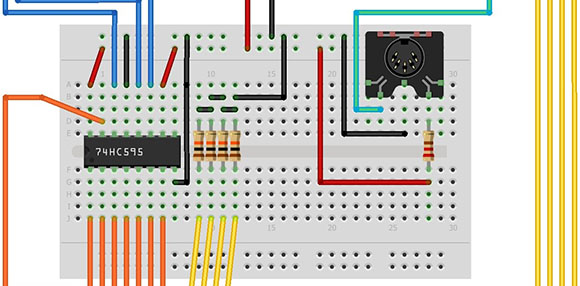
Building a MIDI device is always a great microcontroller project, and nearly everyone has an old toy keyboard lying around in the back of a closet or in the basement. [JenShen] decided to take one of these toy keyboards and build a MIDI keyboard.
The keyboard [JenShen] used was a simple Casio keyboard with built-in voices. After tearing out the guts of the keyboard, the only thing that remained is the row of push buttons underneath the keys. These buttons were laid out in a row/column matrix, so [JenShen] needed to decode this matrix before sending the result to an Arduino for processing.
A 74HN595 shift register was used to read the 8 rows of buttons underneath the keys, while the rows were tied to different input pins on the ‘duino. This allowed [JenShen] to scan the keyboard matrix with an Arduino and generate MIDI notes and send them to other synths.
In the video after the break, you can check out [JenShen]’s circuit and code that allowed him to turn a toy keyboard into a proper 32-note MIDI keyboard. It’s not velocity sensitive, but he says he’ll show everyone how to accomplish that in a future post.
[youtube=http://www.youtube.com/watch?v=AEqzr5NUdQo&w=470]
















Love it :)
Nice, but I was expecting one of the old classic mechanical toy pianos.
What’s the clock rate for the shift register and what’s the total response time (from keypress to MIDI signal) for the whole setup?
Hi John, I’ve left it default 16Mhz clock. so each of 8 columns scanned with about 2Mhz clock. I have not played much with this but I believe clock speed can be reduced to save some power. Response was not measured but it is by feel is instantaneous.
Great job would have liked to see the original functionality maintained with this setup also. with a midi in so that you could send midi in to the keyboard and get the Casio sounds. :) that’s a mod we did a long time ago http://www.illuminatedsounds.com/?p=10
There is always this classic
http://www.headfuzz.co.uk/midihack
Hi All, I’ve prepared a follow up post on how to add Velocity sensitivity and Aftertouch effects to the project. Read more here: http://www.codetinkerhack.com/2013/01/how-to-add-velocity-aftertouch-midi.html
Thanks for post this great. I’m a long time reader but ive never commented till now.
Thanks again for the awesome post.